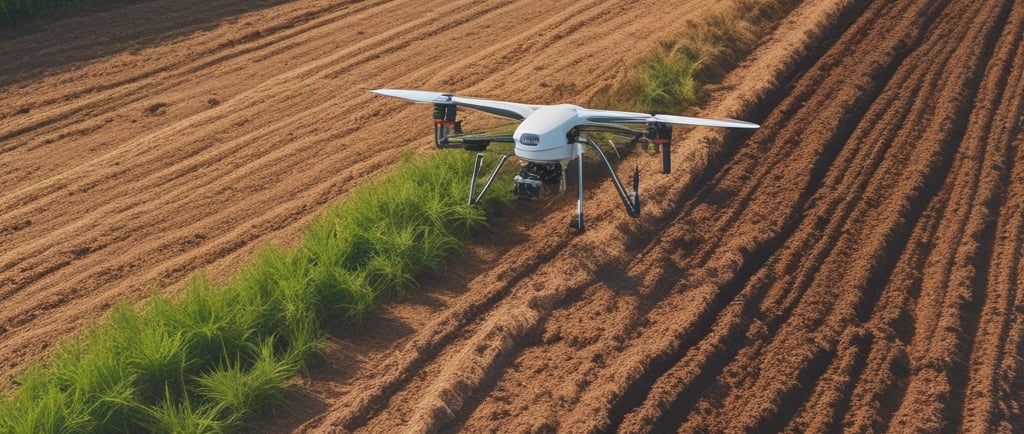The Quiet Revolution: How AI at the Edge is Fighting Poverty with Data and Precision
Jon Hanania
10/6/20254 min read


When we think of Artificial Intelligence, we often picture vast, humming data centers. And when we think of fighting poverty, we imagine food banks and international aid. It’s time to connect these two worlds, because a powerful, quiet revolution is happening where they meet: at the edge.
Edge AI runs directly on local devices—like smartphones, sensors, or low-cost microprocessors—instead of relying on a distant cloud. This means intelligence is immediate, on-site, and accessible even without a constant internet connection. It's moving AI from the cloud to the dirt, the clinic, and the village market, and the data-driven results are staggering.
Here’s how.
1. Precision Agriculture: From Guesswork to Data-Driven Harvests
For the world's 500 million smallholder farmers, a single bad harvest can mean disaster. Edge AI is turning their phones and fields into hubs of intelligence. Consider the real-world impact of an app like PlantVillage, used by over 1.5 million farmers in Africa. A farmer can take a picture of a diseased plant, and the edge AI model on the phone identifies the pest or blight with over 90% accuracy, recommending a targeted treatment. A 2022 study in Kenya showed that farmers using this AI advice saw crop losses from Fall Armyworm drop to under 4%, compared to over 60% for non-users. Similarly, organizations like Wadhwani AI in India use smartphone-based AI to count pests in cotton fields, which has reduced pesticide use by 25-40% and saved farmers an average of $50 per acre. The impact is clear: increased food security and higher incomes for farming families, making them more resilient to climate shocks.
2. Democratizing Healthcare: The Doctor in Your Pocket
Access to qualified medical professionals is a critical challenge in remote and low-income communities. Edge AI is putting diagnostic tools directly into the hands of community health workers. For instance, Butterfly Network's handheld, smartphone-connected ultrasound devices use edge AI to help guide non-specialists in capturing clinical-grade images. In rural Rwanda, this technology led to a more than 50% increase in the detection of high-risk pregnancies. Another example is the Artilux app, which uses a smartphone's camera to scan for anemia by analyzing the coloration of a person's fingernail bed. In trials with over 1,000 pregnant women, it detected anemia with approximately 90% sensitivity and specificity, enabling rapid screening in communities with no access to labs. The result is earlier detection of diseases, reduced child and maternal mortality, and more efficient use of limited healthcare resources.
3. Financial Inclusion: Banking the Unbanked
Over 1.4 billion adults remain unbanked. Without a credit history, they are locked out of loans to start a business or insure their crops. Edge AI is building bridges by creating financial identities from alternative data. Tala, a financial services app, uses edge AI to analyze over 10,000 data points on a user’s smartphone (with permission)—such as SMS patterns and mobile money transactions—to build a credit score in minutes. They have disbursed over $3 billion in microloans to more than 8 million customers, with the average first-time loan being just $25. Another platform, BanQu, helps refugees and subsistence farmers create an economic identity by tracking their transactions and harvests on a simple phone. One pilot with cassava farmers in Africa showed a 30% increase in their ability to access credit because they could now prove their farming history. The impact is profound economic empowerment and the ability to start small businesses.
4. Smarter Aid and Disaster Response
Aid distribution can be inefficient, with resources sometimes failing to reach those who need them most. In disaster scenarios, every minute counts. The World Food Programme has piloted the use of edge AI on drones and smartphones to assess building damage after a disaster. The model can analyze images and classify structures as "destroyed," "damaged," or "intact" with high accuracy, reducing assessment time for a large area from several weeks to just 48 hours. Similarly, Zipline's delivery drones, powered by AI that optimizes flight paths in real-time, have delivered over 1 million units of blood, vaccines, and medicine to remote clinics. In Rwanda, they reduced the average delivery time for emergency blood from 4 hours to under 30 minutes. This leads to faster, more efficient, and more equitable distribution of critical aid.
Why "Edge" Makes All the Difference
You might wonder, "Couldn't the cloud do this?" The answer is often no, and here’s why the edge is so crucial. It works offline, which is vital in communities with limited or no internet. It provides low latency, giving instant answers for diagnosing a crop disease or a medical scan. It is cost-effective, using far less power and data, which is essential for people with limited resources. And it enhances data privacy, as sensitive information like health or financial data can be processed on the device itself, never needing to leave the user's possession.
The Road Ahead
The potential, backed by these compelling data points, is immense. The narrative of AI as a job-taker or a tool for the wealthy is being rewritten at the edge. It’s becoming a partner, a protector, and an equalizer. By putting the power of intelligent computing directly into the hands of those on the front lines of poverty, we are not just offering aid—we are enabling agency, resilience, and sustainable growth. The future of poverty alleviation isn't just about more resources; it's about smarter ones. And that intelligence, as the data shows, is now decisively moving to the edge.
